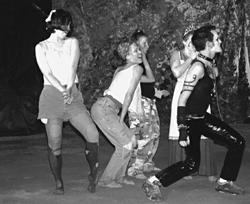

Opening on an evening brightened by a full moon, an experiential performance is blossoming in the Jones Fieldhouse this weekend. The players aren't trying to be smooth and theatric, instead the focus is on the cryptic and mysterious. This emphasis unites the performance from the twanging guitars that introduce the first scene all the way through to the mass group gatherings that mark the end of the show.
The play was written by the honorable Eriq Von Ripworth between 1995 and 1997, and has been performed in different settings each of the last two years. Never, however, has the performance been executed on such a grand scale with the set and cast that it displays this weekend. The playwright invented an entirely new vocabulary for his work, and a glossary of terms and expressions is included in the back of the program. One of the terms is Microblast, defined as "an indescribable once-in-a-lifetime freak weather event." This performance could be defined with a similar word.

The set, designed by Erin Sickler, is constructed on a huge scale with a floating set of colored cloths that transform the dirty Jones Fieldhouse into an elongated stage. During the course of the play, the scene changes introduce large-scale paintings and drawings that serve as a backdrop to the bizarre scenes that unfold from the billowing cloths. The play leaps through time and space, but it is all set in the American West and focused around a mysterious mineshaft. The mine shaft has a strange effect on those who enter, and the second scene is narrated by a mess cook named Jeremiah Wood (college senior Andrew Richardson) who watches the effect of the silver mine on the miners who resurface after long spells underground.
At the play's intermission, French-speaking green space aliens brought "Cosmic inertia globs" and hot cocoa with honey into the audience, adding yet another layer to the sensory input of the evening. During the intermission, many people smoked cigarettes and took nips from small glass bottles.
In one of the strangest twists, Rippy Manson, a demented cult leader played by Von Ripworth, reunites with his brother Marilyn (played by College first-year Matt Marlin) and pulls out some tortured truths about his relationship to his parents and himself, that somehow seem less significant in light of all the madness around him.
The audience was always on the edge of laughter if not fully knee-slapping and roaring, because the cast and costumes were so ridiculously constructed. From time to time, bunny rabbits bounce out to spread the goodness from underground and bring hot cocoa up to the surface.
Many theater performances at Oberlin are full-scale attempts at famous plays, but rarely do you see the same play repeated more than once in different settings. The Excavation of the Midnight Shaft has successfully changed to fill larger spaces and satisfy a different audience in every year of its existence, and this ability to change while sticking to the same plot line has enabled the play to persist and remain an event on the Oberlin campus.
College Senior Lizzy Latimer directs the chaos, and evidently has a good enough knowledge of the movements and dynamics of the cast that she can give them a framework for improvisation. The sound design helps tremendously in the echoing fieldhouse, setting a strangely otherworldly mood to the events. The cast is mainly composed of Harkness characters, and is an accouterment to a weekend of festivities that mark the fiftieth anniversary of the co-op.
In this performance, the drama is constructed from bare bones, and laughter reigns through the chaos to make The Excavation of the Midnight Shaft an experiential trip you may want to step into this weekend. You will walk out of the fieldhouse seeing circles everywhere, and they will be pulsing.
Get your groove on: The cast of Shaft gets down with the surrealist grooves in Jones Field House. (photo by Stephen Menyhart)
Copyright © 1999, The Oberlin Review.
Volume 127, Number 22, April 30, 1999
Contact us with your comments and suggestions.